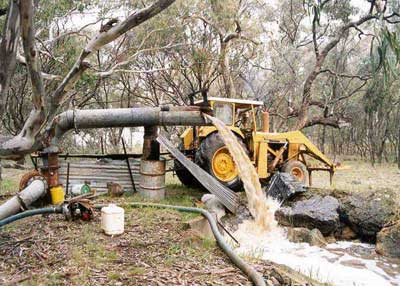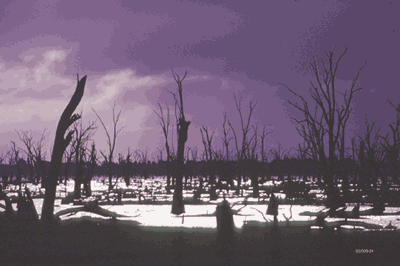Many of Australia’s river systems have been regulated to meet agricultural, urban and industrial requirements for freshwater, and this has led to alterations in the natural timing and volumes of freshwater entering many coastal waterways. Until relatively recently, it was commonly believed that water flowing to estuarine and marine areas was a wasted resource1. However, we now know that freshwater flows are important in shaping the physical, chemical and biological characteristics of our coastal waterways. Indeed, the environmental water requirements of coastal waterways is now recognised as a key issue in the management of Australia’s natural resources, primarily because demand for the freshwater resource, from upstream competing users, is expected to strengthen with future population growth2. “Environmental water” (or “environmental flow”) is the amount (and timing) of freshwater that is required to maintain the health of aquatic ecosystems3.

Photo 1. An irrigation diversion pump on the Avoca River, western Victoria, drawing water directly from the stream channel and pumping to an adjacent storage dam. (Photo by Paul Close).
Human activities that alter environmental flows
Estuaries are unique systems forming a link between marine and freshwaters. The interaction between marine and freshwater creates hydrodynamics unique to estuaries in which both the natural variation in freshwater inputs and the flood and ebb tidal flows are essential for maintaining estuarine health.
Human activities in upstream reaches of coastal catchments can alter critical components of estuarine hydrodynamics which may result in fundamental changes to the physical, chemical and biological characteristics of estuaries, and in turn lead to a reduction in estuarine health. Reservoirs and diversion structures such as dams, weirs and barrages, and direct pumping of water from the stream channel for domestic, industrial and intensive agriculture (photo 1 and 2) can directly alter the natural magnitude and variation of riverine flows. Modifications to stream channels such as channel straightening for flood mitigation or channel dredging can also directly impact on more subtle components of natural flow regimes such as the duration of high flow events3.

Photo 2. A dam in the Murray Basin (photo by K.W.F. Howard).
Land use and management practices, such as the removal of riparian buffers, clearing of native forests, and expansion of urban areas can also change the natural timing, magnitude and duration of rainfall runoff and ultimately increase the volume of stormwater that is generated within a catchment.
Modification of the entrance of the coastal waterway, particularly wave-dominated estuaries, deltas and coastal lagoons, can affect the volume and frequency of flood and ebb tidal flows. These are discussed in more detail in the Hydrodynamic Alterations information sheet.
Relevant pressure indicators
Listed below are some indicators that can be used to assess the various human activity pressures.
- The density of impoundments is an indicator that was developed during the National Land and Water Resources Audit to assess the degree of disturbance on a flow regime caused by dams, reservoirs, weirs, locks/sluice gates and other minor structures. However, the overall proportion of catchment flow that is intercepted may prove to be a more realistic indicator, and is worthy of exploration.
- The volume of stormwater generated is a suggested indicator for State of the Environment reporting (Human Settlements Theme) to assess disturbance pressure on the flow regime caused by urbanisation.
- The rivers through forests indicator was developed during the National Land and Water Resources Audit to assess the degree of disturbance to riparian zones.
Impacts on coastal waterways of altered environmental flows
Critical physical and chemical processes may be affected if the natural magnitude and variation of freshwater inflow to coastal waterways is modified. Some of these processes potentially at risk due to flow modification have been summarised in recent checklists3 4 1. For example freshwater flow affects:
- nutrient supply and primary productivity. Reduced freshwater inflow can promote algal blooms because the residence times of algal biomass and nutrients are increased, and because fine sediment loads are reduced (hence turbidity decreases and light penetration increases) and;
- the salinity regime. Most estuarine biota have specific salinity requirements which may vary depending on the stage that they are at in their life cycle. Many fish species use freshwater and salt water habitats at various times (opportunistically, annually, seasonally and for different reasons (early development, growth, spawning) during their life cycles (e.g. Mullet, Bass and Barramundi), and the salinity gradients have been identified as the most important factor in the successful recruitment of larval and juvenile fish in South African estuaries5. The dissipation of salinity gradients under reduced freshwater inflow or enhanced tidal flows (e.g. by training walls or dredging at the entrance) therefore has the potential to contract the amount of freshwater habitat required by some species. In addition, weirs and physical barrages can impact upon longitudinal and lateral connectivity in the “critical chain”6 of habitat types required to maintain a productive and diverse fisheries resource.
- Catch of estuarine fish and crustaceans. Freshwater flows into tropical estuaries help support major commercial and recreational fisheries for barramundi and banana prawns with improved catchability7, enhanced survival of juveniles8 and faster growth rates9 being correlated with increased freshwater flows.
Geomorphological changes may also occur in coastal waterways with impacted freshwater flows because sediment supply and movement are altered. For example:
- A reduction in flood frequency (e.g. due to the instillation of a major dam in the catchment) has been linked to increased sediment deposition and reduced erosion in coastal waterways. Channel dimensions in coastal waterways are principally determined by the scouring action of floods. A reduction in flood frequency typically results in gradual subtidal shoaling, formation of sandbars, and constriction of channels10. Conversely, increased flood frequency (e.g. due to extensive catchment clearing) can result in greater erosion of channel cutbanks and alteration of estuarine geomorphology.
- Reduced flow, and consequently reduced erosive capacity, can cause geomorphic changes to estuarine entrances, such as the expansion of flood tidal deltas11 10. Entrance constriction may lead to an increased frequency of entrance closure in coastal lagoons and small wave-dominated estuaries, altering the tidal regimes in the waterway12.
Relevant biophysical indicators
There is a pressing need to develop hydrodynamic/hydrologic, geomorphic and ecological indicators that are clearly linked to environmental flows. One such indicator – the landward displacement of the 2 ppt isohaline position signifying the dissipation of salinity gradients when freshwater inflow is reduced, and its seaward displacement when salinity gradients expand under increased freshwater inflow – is linked to important base-components of food-webs and to the abundance and survival of several species in estuaries overseas13, and is worthy of exploration in Australia. Other potential indicators of changes in the amount of freshwater/marine inflow are:
- shifts in the position of the turbidity maximum.
- changes in water column pH levels in upper and middle estuaries. Average pH levels will increase (in concert with salinity) if freshwater flow is reduced, and will decrease if freshwater flow increases14. However the magnitude of this indicator is also strongly influenced by photosynthesis.
- the alkalinity/Cl ratio is also sensitive to changes in the degree of mixing between seawater and meteoric water and there is evidence that crustaceans (and potentially other organisms) are sensitive to this ratio14.
- Changes in the relative abundance of estuarine biota sensitive to salinity. For example, changes in the relative abundance of striped leg and yellow-footed hermit crabs is thought to be related to the magnitude of freshwater inflow.
More information on freshwater flow regime (changed from natural) and excess freshwater.
Contributors
Julie Robins, Ian Halliday, Errol McLean, Jon Hinwood, John Bennet, Paul Close
- Coastal Tidings Newsletter, Issue 1, June 2001 (coastal_tideings_newsletter) ↩ ↩
- Postel, S.L. 1998. Water for food production: Will there be enough in 2025? BioScience 48, 629-637. ↩
- Pierson, W.L., Bishop, K., Van Sendon, D., Horton, P.R., and Adamantidis, C.A. 2002. Environmental Water Requirements to Maintain Estuarine Processes, Environmental Flows Initiative Technical Report, Report Number 3, Commonwealth of Australia. ↩ ↩ ↩
- See collection of papers in Estuaries 25(6B): December 2002. ↩
- Whitfield, A.K. 1994. Abundance of larval and 0+ juvenile marine fishes in the lower reaches of three southern African estuaries with differing freshwater input. Marine Ecology Progress Series 105, 257-267. ↩
- Cappo, M., Alongi, D.M., Williams, D, and N. Duke. 1995. A review and synthesis of Australian Fisheries Habitat Research: Major threats, issues and gaps in knowledge of coastal and marine fisheries habitats. Fisheries Research and Development Corporation. ↩
- Robins, J., Mayer, D., Staunton-Smith, J., Halliday, I., Sawynok B., and Sellin, M. 2006. Variable growth rates of the tropical estuarine fish barramundi Lates calcarifer (Bloch) under different freshwater flow conditions. Journal of Fish Biology 69, 379-391. ↩
- Staunton-Smith, J., Robins J. B., Mayer, D. G., Sellin, M. J., and Halliday, I. A. (2004). Does the quantity and timing of freshwater flowing into a dry tropical estuary affect year-class strength of barramundi (Lates calcarifer)? Marine and Freshwater Research 55, 787-797. ↩
- Robins J. B., Halliday I. A., Staunton-Smith J., Mayer D. G., and Sellin, M. J. 2005. Freshwater-flow requirements of estuarine fisheries in tropical Australia: a review of the state of knowledge and application of a suggested approach. Marine and Freshwater Research 56, 343-360. ↩
- Reddering, J.S.V. 1988. Prediction of the effects of reduced river discharge on the estuaries of the south-eastern Cape Province, South Africa. South African Journal of Science 84, 726-730. ↩ ↩
- Harris, P. T. and Heap, A. D., (2003) Environmental management of clastic coastal depositional environments: inferences from an Australian geomorphic database. Ocean and Coastal Management. 46(5):457-478. ↩
- Bourman, R.P., Murray-Wallace, C.V., Belperio, A.P. & Harvey, N. (2000). Rapid coastal geomorphic change in the River Murray Estuary of Australia. Marine Geology, 170, 141-168. ↩
- Jassby, A.D., Kimmerer, W.J., Monismith, S.G., Armor, C., Powell, T.M., Schubel, J.R., and Vendlinski, T.J. 1995. Isohaline position as a habitat indicator for estuarine populations. Ecological Applications 5(1), 272-289 ↩
- Radke, L.C. 2002. Water allocation and critical flows: potential ionic impacts on estuarine organisms. Proceedings of Coast to Coast 2002 – “Source to Sea”, Tweed Heads, pp. 367-370. ↩ ↩


